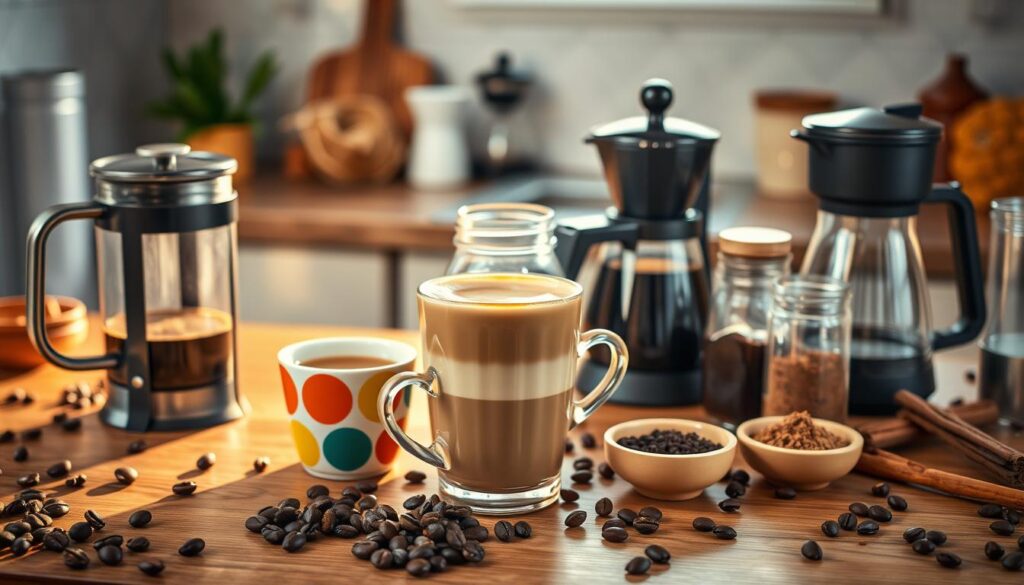Want a cafe-quality coffee without leaving home? Learn to make tasty DIY coffee drinks with pantry items. These recipes will make your morning coffee a gourmet treat, easy and delicious.
Coffee fans, rejoice! You don’t need fancy gear or exotic beans to make amazing drinks. With a few tricks and common items, you can become a home coffee expert and improve your coffee.
Key Takeaways
- Master gourmet coffee recipes using everyday ingredients
- Save money by creating cafe-style drinks at home
- Explore creative coffee brewing techniques
- Customize your coffee with simple pantry ingredients
- Impress friends and family with professional-quality drinks
Transform Your Kitchen into a Coffee House Experience
Creating a professional coffee experience at home is easy. You don’t need expensive equipment or hard techniques. With the right tools and simple ingredients, you can make cafe-quality drinks at home.
Essential Equipment for Home Coffee Brewing
Getting the right coffee equipment changes your morning. Here are the key tools for a great home brewing setup:
- Drip coffee maker or French press
- Burr coffee grinder
- Digital kitchen scale
- Milk frother
- Thermometer
Basic Ingredients You Already Have
Your pantry has ingredients that can make your coffee better. Spices, sweeteners, and milk alternatives can really enhance your coffee:
| Ingredient Category | Examples | Flavor Impact |
|---|---|---|
| Spices | Cinnamon, Nutmeg | Warm, complex notes |
| Sweeteners | Honey, Maple Syrup | Natural, rich sweetness |
| Milk Alternatives | Almond, Oat Milk | Creamy texture |
Creating the Perfect Coffee Base
The base of any great coffee is key. Start with fresh beans, use filtered water, and keep brewing temperatures steady. Try different grinds and methods to find your favorite taste.
Pro tip: Always use freshly roasted beans and grind just before brewing for maximum flavor!
Understanding Coffee Beans and Brewing Methods
Coffee lovers know that the perfect cup starts with knowing coffee beans and brewing methods. Coffee beans from Ethiopia’s highlands to Colombia’s volcanic soils have their own stories. Each one brings a unique flavor and complexity.
Let’s dive into the world of coffee extraction and roasts. These steps turn simple beans into a delicious drink. Different brewing techniques can greatly change your coffee’s taste.
Coffee Bean Varieties
- Arabica: Known for smooth, complex flavors
- Robusta: Stronger, more bitter with higher caffeine content
- Liberica: Rare beans with unique woody taste
Roast Levels Impact
| Roast Level | Flavor Profile | Caffeine Content |
|---|---|---|
| Light Roast | Bright, acidic | Highest |
| Medium Roast | Balanced, smooth | Moderate |
| Dark Roast | Rich, bold | Lowest |
“Great coffee is an art, and understanding your beans is the first brushstroke.” – Coffee Artisan
Mastering coffee extraction means knowing how water temperature, grind size, and brewing time work with different beans. Each brewing method – from French press to pour-over – highlights unique qualities in your beans.
5 Gourmet Coffee Recipes Using Simple Pantry Staples
Turning your kitchen into a coffee lover’s dream doesn’t need fancy ingredients or barista skills. These gourmet coffee recipes show how to make tasty coffee drinks with pantry items. Let’s dive into five unique homemade lattes that will make your coffee time special.
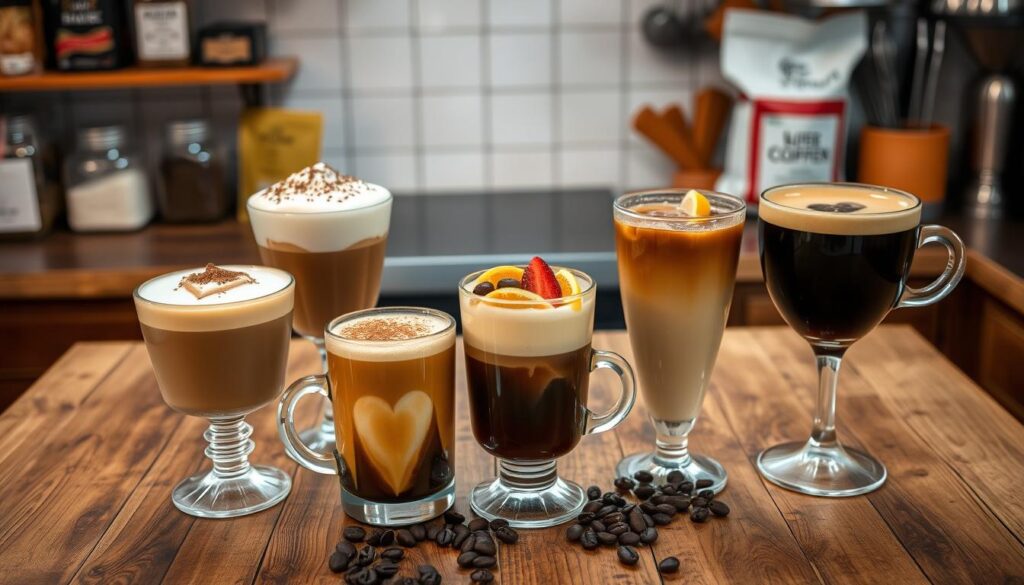
Each coffee variation brings a new twist to your usual cup. It shows that a little creativity can make a big difference in your coffee experience.
Homemade Vanilla Latte
Make a smooth and comforting vanilla latte with just a few ingredients:
- Strong brewed espresso or coffee
- Milk of choice
- Pure vanilla extract
- Optional sweetener
“A perfect vanilla latte is all about balance and quality ingredients” – Coffee Enthusiast Magazine
Cinnamon Mocha Delight
Combine rich chocolate and warm cinnamon for a decadent coffee. This recipe turns your morning coffee into a luxurious treat, like dessert.
Coconut Caramel Coffee
Blend tropical coconut with sweet caramel for a unique flavor. This coffee will change your daily coffee routine.
Spiced Honey Coffee
Add natural sweetness and warm spices to your coffee. This recipe is a sophisticated choice for sweet coffee drinks.
Maple Nutmeg Coffee
Enjoy an autumnal coffee that’s full of comfort and warmth. The mix of maple and nutmeg makes this coffee unforgettable.
These gourmet coffee recipes show you can make amazing coffee at home. With simple pantry items and creativity, you can make drinks as good as those from a café, right in your kitchen.
Mastering the Art of Coffee Measurements
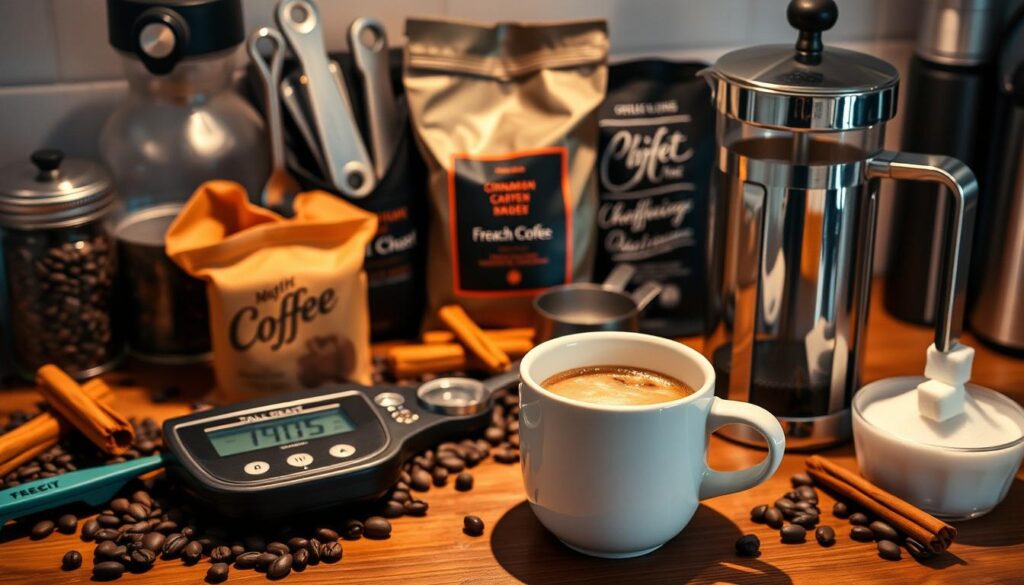
Brewing the perfect cup of coffee is a delicate science. It starts with precise coffee measurements. Coffee lovers know that getting it right can turn a simple drink into a special experience.
The coffee-to-water ratio is key to great coffee. Experts suggest a standard ratio for the right balance of strength and flavor:
- Drip Coffee: 1:16 ratio (1 gram of coffee per 16 grams of water)
- French Press: 1:15 ratio for bolder flavor
- Espresso: 1:2 ratio for intense concentration
“Precision in coffee measurements is the difference between a good and a great cup of coffee.” – Professional Barista
To get consistent coffee strength, you need to be precise with your measurements. Digital scales are the best way to measure coffee. They help avoid mistakes and ensure you get the same taste every time.
| Brewing Method | Coffee Measurement | Water Temperature |
|---|---|---|
| Pour Over | 22-25 grams | 195-205°F |
| Drip Machine | 15-20 grams | 195-205°F |
| French Press | 30-35 grams | 195°F |
Pro tip: Always measure your coffee and water by weight, not volume, for the most accurate brewing precision.
Knowing these measurements lets home brewers try new things and find their own style. Start with the standard ratios and then adjust to your liking.
Creative Coffee Sweeteners and Substitutes
Enhancing your coffee at home is more than just making a good cup. The right sweeteners and flavorings can turn a simple drink into a gourmet treat. Trying out natural sweeteners and milk alternatives can lead to many tasty options.
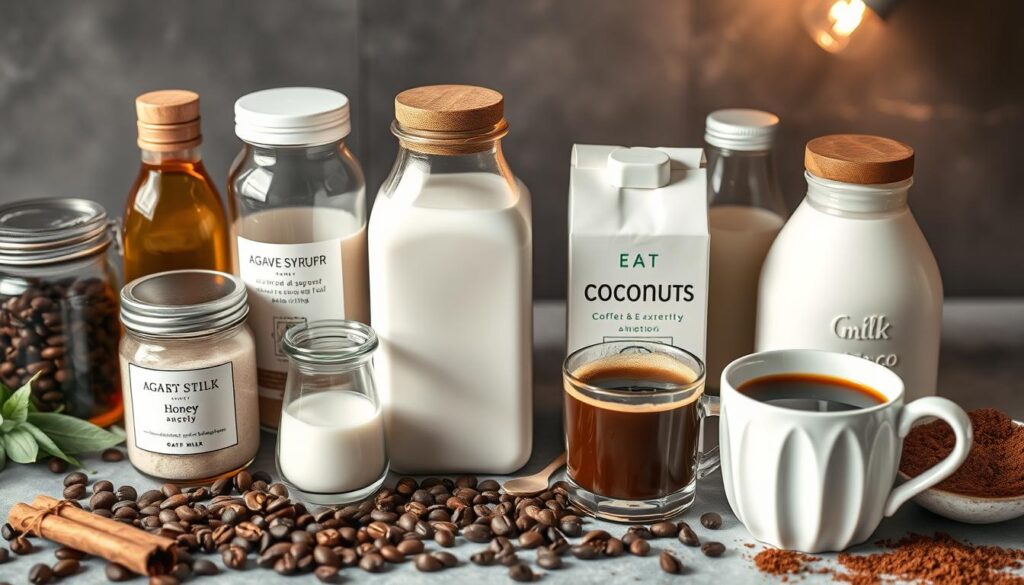
Natural Sweetening Options
Forget about refined sugar and try these natural sweeteners. They add depth and complexity to your coffee:
- Raw honey: It has a floral sweetness and natural antioxidants
- Maple syrup: It gives a rich, caramel-like taste
- Coconut sugar: It has a subtle caramel flavor
- Stevia: A zero-calorie sweetener from a plant
Dairy and Non-Dairy Milk Alternatives
| Milk Alternative | Flavor Profile | Nutritional Benefit |
|---|---|---|
| Almond Milk | Nutty, light | Low calorie, vitamin E |
| Oat Milk | Creamy, slightly sweet | High in fiber |
| Coconut Milk | Tropical, rich | Healthy medium-chain triglycerides |
Flavor Enhancement Tips
Try adding simple ingredients to your coffee. A pinch of cinnamon, a dash of vanilla, or a sprinkle of nutmeg can make your coffee special.
“The art of coffee is in the details – even the smallest ingredient can create magic.” – Coffee Enthusiast
The best coffee is the one you love. Feel free to mix and match these sweeteners and milk alternatives to find your favorite cup.
Temperature and Timing: Keys to Perfect Coffee
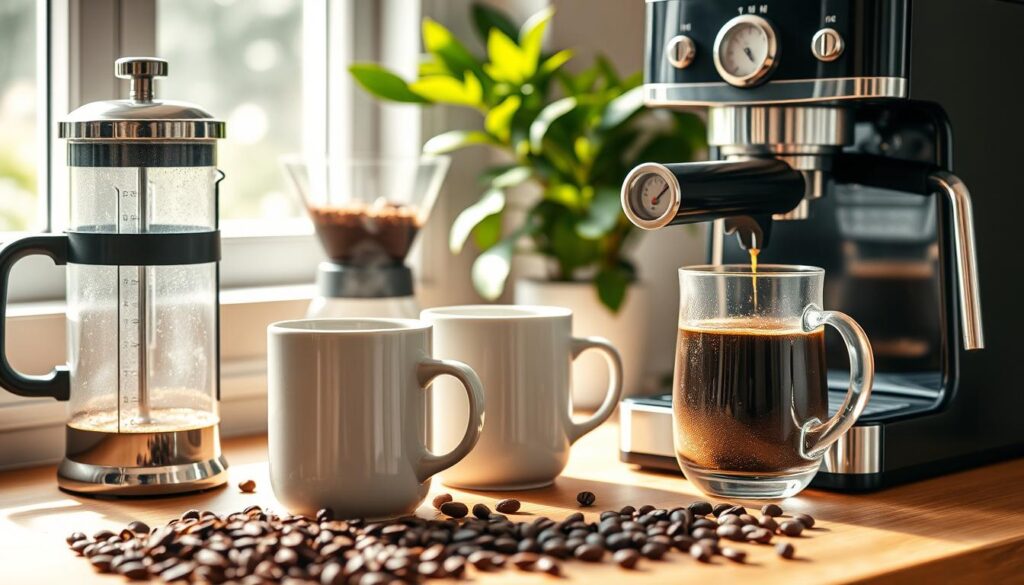
Making the perfect cup of coffee is an art. It depends on two key things: the coffee brewing temperature and how long it’s brewed. Professional baristas say getting these right can turn a regular coffee into a special treat.
“The difference between good coffee and great coffee is often just a few degrees.” – Coffee Experts
Learning about coffee starts with the water temperature. The best brewing temperature is between 195°F and 205°F. This ensures the coffee tastes its best. Water that’s too hot can make the coffee taste bitter. Water that’s too cool makes it weak and not flavorful.
- Optimal water temperature: 195°F – 205°F
- Typical extraction time: 3-4 minutes
- Recommended brewing methods: Pour-over, French press, drip coffee
How long you brew the coffee is also important. Different methods need different times to get the best flavor. A well-decorated coffee station can help you be more precise with your brewing.
| Brewing Method | Ideal Temperature | Extraction Time |
|---|---|---|
| Pour-Over | 200°F | 3-4 minutes |
| French Press | 195°F | 4-5 minutes |
| Espresso | 202°F | 25-30 seconds |
Pro tip: Invest in a digital thermometer to ensure consistent water temperature for every brew.
Troubleshooting Common Coffee Making Mistakes
Every coffee lover faces challenges when brewing their perfect cup. Troubleshooting coffee needs patience, practice, and knowing common mistakes. By learning to fix these issues, your coffee-making experience can go from bad to great.
Fixing Bitter Coffee
Bitter coffee can spoil your morning. Here are ways to fix it:
- Reduce brewing time to prevent over-extraction
- Use freshly ground beans for optimal flavor
- Check water temperature (ideal range: 195-205°F)
- Clean your coffee equipment regularly
Achieving the Right Consistency
Consistency is key for great-tasting coffee. Each brewing method needs its own approach:
- French Press: Coarse grind, steep for 4 minutes
- Drip Coffee: Medium grind, consistent water flow
- Espresso: Fine grind, high pressure extraction
Storage Solutions
Storing coffee right is vital for keeping it fresh. Keep your beans away from moisture, light, and air. Here are some storage tips:
- Use airtight containers
- Store in cool, dark places
- Avoid refrigerator storage
- Buy smaller quantities for maximum freshness
“Great coffee starts with great storage” – Coffee Masters Worldwide
Seasonal Adaptations for Your Coffee Recipes
Coffee lovers know that seasonal coffee drinks are more than just a trend. They’re a delightful way to explore unique flavors throughout the year. Each season brings an opportunity to transform your favorite coffee recipes into exciting new experiences.
Summer calls for refreshing iced coffee variations that cool you down and energize your day. Try these creative approaches to reimagine your coffee routine:
- Tropical Cold Brew: Infuse your iced coffee with coconut water and a splash of pineapple juice
- Lavender Mint Iced Latte: Add fresh mint leaves and lavender syrup to create a cooling summer drink
- Watermelon Espresso Cooler: Blend cold espresso with fresh watermelon for a unique twist
Winter holiday coffee recipes offer warm, comforting alternatives that celebrate seasonal flavors. Spices and rich ingredients transform simple coffee into extraordinary beverages.
| Season | Coffee Adaptation | Key Ingredients |
|---|---|---|
| Fall | Pumpkin Spice Latte | Cinnamon, nutmeg, pumpkin puree |
| Winter | Gingerbread Mocha | Ginger, molasses, dark chocolate |
| Spring | Lavender Honey Coffee | Local honey, dried lavender |
| Summer | Citrus Cold Brew | Orange zest, vanilla extract |
“Seasonal coffee adaptations are like culinary adventures in a cup – each sip tells a story of time and place.”
Experimenting with seasonal ingredients allows you to craft unique coffee experiences. These experiences reflect the changing landscape of flavors. From spicy winter warmers to light summer refreshments, your home brewing can become a creative journey of taste and imagination.
Presentation and Serving Tips
Improving your coffee presentation can turn a simple drink into a special treat. Serving coffee in creative ways can make it taste better and more enjoyable. It’s not just about pouring coffee into a mug.
- Use cocoa powder stencils for intricate designs
- Experiment with cinnamon sprinkles
- Create elegant whipped cream swirls
- Add edible flower petals for sophistication
Latte art is easy to master at home. Simple steps can make your coffee look like it was made by a pro:
- Start with smooth, glossy milk foam
- Pour milk slowly from a slight height
- Practice basic heart and rosetta patterns
- Use a thin-spouted pitcher for precision
Choosing the right serving vessel matters as much as the coffee itself. The right glassware can enhance the coffee’s flavor:
| Coffee Type | Recommended Glassware | Presentation Style |
|---|---|---|
| Espresso | Small ceramic cup | Minimal, focused design |
| Latte | Clear tall glass | Layered presentation |
| Cappuccino | Wide-rimmed ceramic mug | Foam art showcase |
“Great coffee is an art form that begins with presentation” – Coffee Enthusiast Magazine
Remember, how your coffee looks can make it taste better. With these tips, you’ll wow yourself and your guests every time.
Conclusion
Making gourmet coffee at home is more than a skill—it’s an art. It turns your kitchen into a cozy café. This guide shows you can make amazing coffee without fancy gear or training.
It just takes simple ingredients and a love for brewing. Anyone can make tasty drinks that compare to café quality.
Coffee experimentation lets you be creative and find your favorite flavors. Each recipe is a chance to try new things and find your style. Start with recipes like the vanilla latte or maple nutmeg blend.
Keep trying new flavors and methods. It’s all about exploring and enjoying the process.
Your coffee brewing journey is just starting. With practice, you’ll get better and more confident. Every great barista began where you are now, eager to learn.
So, enjoy the learning process and every cup you make. Your skills will grow with each try.
Learning to brew coffee at home saves money and brings joy. Every cup you make is a win for your creativity. So, grab your favorite mug and start exploring these recipes.
Make your home a place of delicious, personal coffee experiences.
FAQ
What equipment do I need to make gourmet coffee at home?
You don’t need to spend a lot to make great coffee. A simple coffee maker, measuring tools, and quality coffee grinder are key. For more fun, try a French press or pour-over for different brewing ways.
Can I make these recipes with regular grocery store coffee?
Yes, you can! These recipes work well with regular coffee or beans from your local store. The secret is using fresh coffee and adding pantry ingredients.
How can I make my homemade coffee taste less bitter?
To avoid bitterness, use fresh beans and avoid over-extraction. Try adding honey or maple syrup. Use a coarser grind and keep your water at 195-205°F for the best taste.
Are these recipes suitable for dairy-free or vegan diets?
Many recipes can be made vegan by using non-dairy milks. Spices, extracts, and natural sweeteners are usually vegan-friendly.
How long can I store homemade flavored coffee?
Enjoy your coffee drinks fresh for the best taste. If you must store them, refrigerate for up to 24 hours. Cold coffee can stay in the fridge for 2-3 days.
Can I adjust the sweetness in these recipes?
Yes, you can! Start with a little sweetener and add more to taste. Options like stevia, honey, or maple syrup let you adjust sweetness easily.
What’s the best way to froth milk at home without an expensive machine?
Froth milk with a whisk, a sealed jar shake, a handheld frother, or blending briefly. Each method gives a different texture, so try them out.
Are these recipes kid-friendly?
Most recipes can be made kid-friendly by reducing caffeine and adjusting spices. You can make decaf versions or use herbal alternatives for fun, kid-friendly drinks.
How can I make my coffee more sustainable?
Choose local, roasted coffee beans and use a reusable filter. Compost coffee grounds and pick sustainable brewing gear. Fair-trade coffee supports ethical production.
What’s the best way to store coffee beans to maintain freshness?
Store beans in an opaque, airtight container away from light, heat, and moisture. Keep them at room temperature and avoid refrigeration. Buy small amounts for freshness.
Share this post: on Twitter on Facebook

